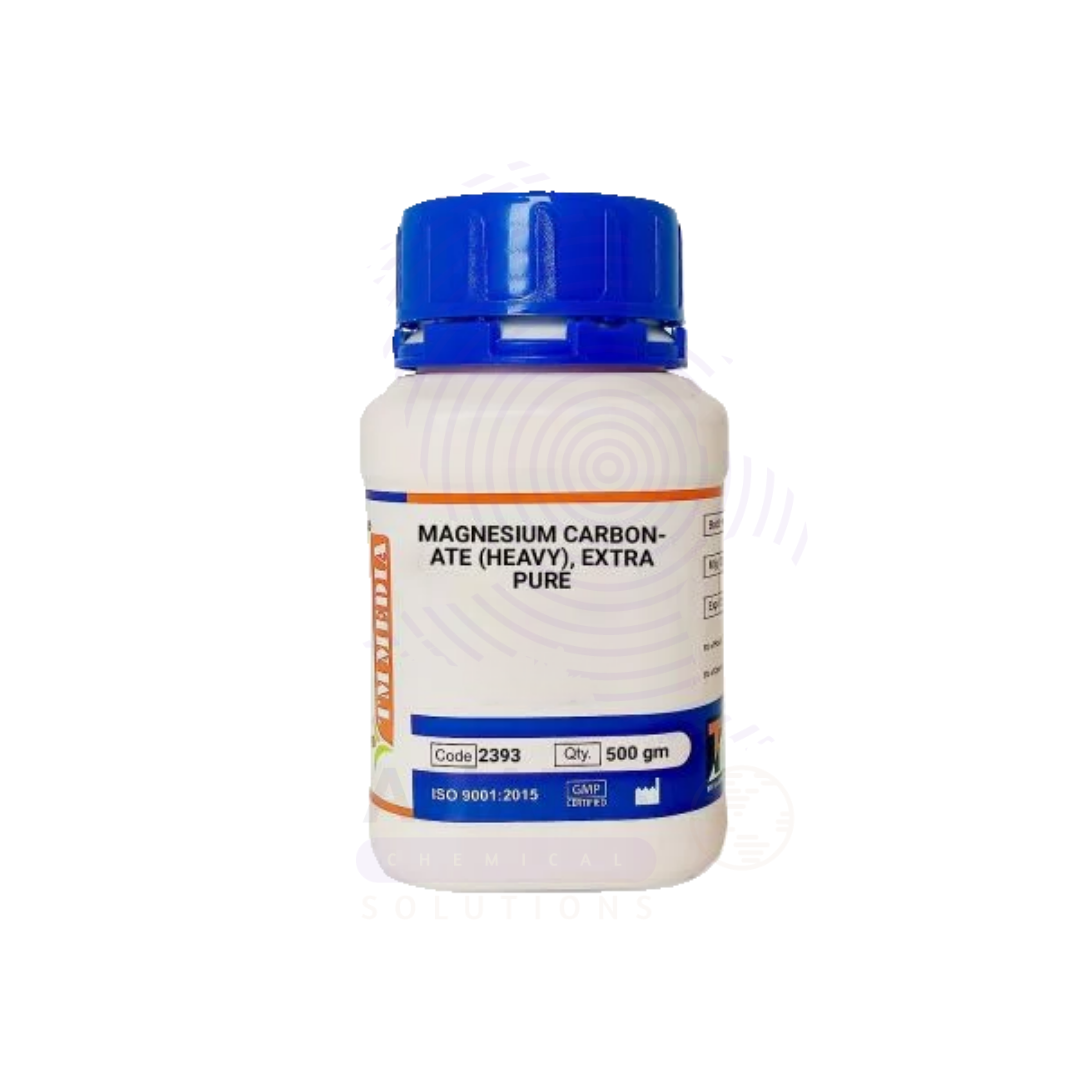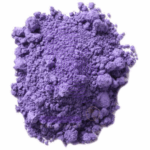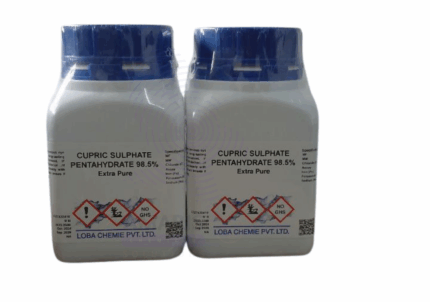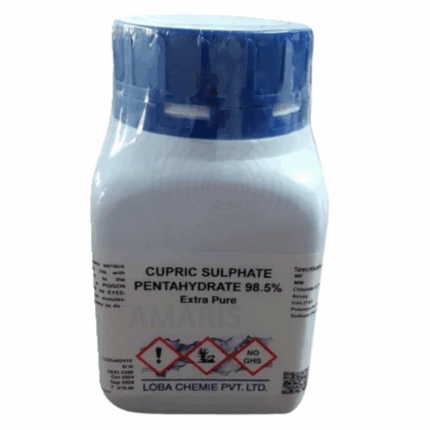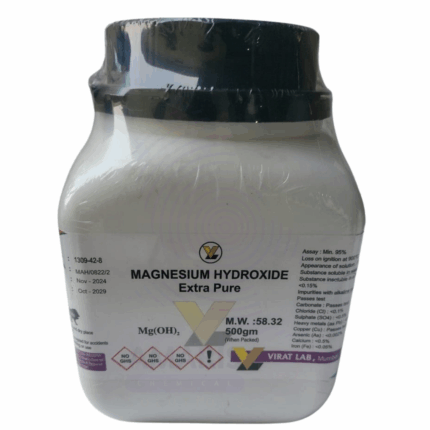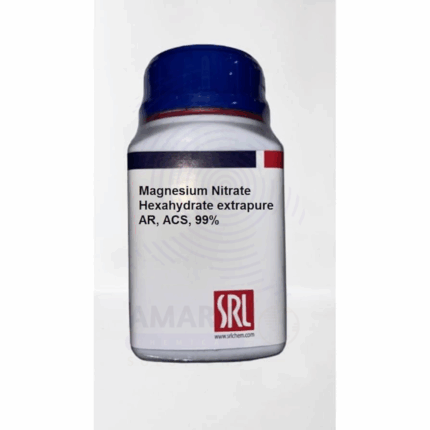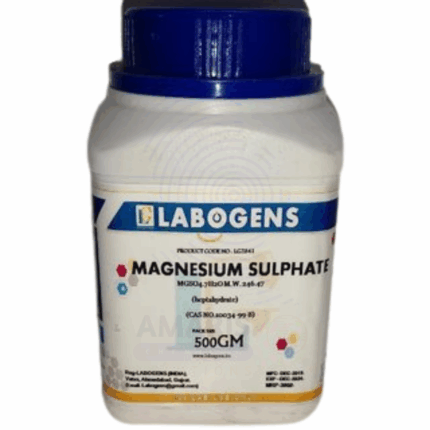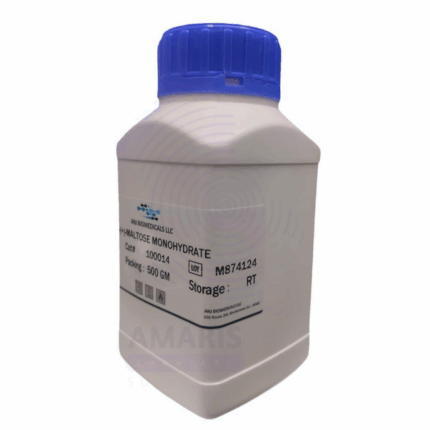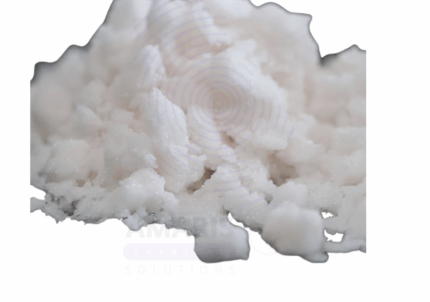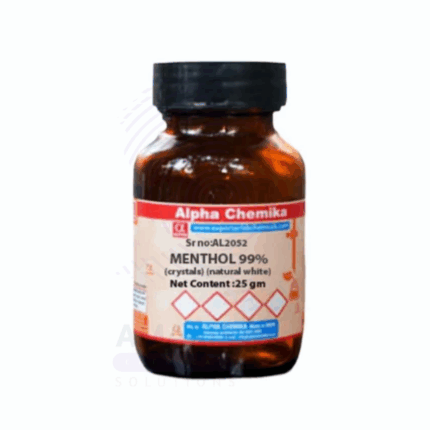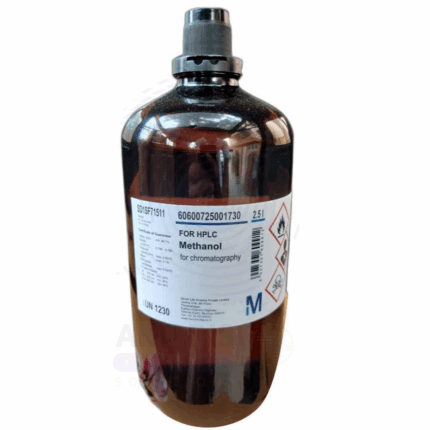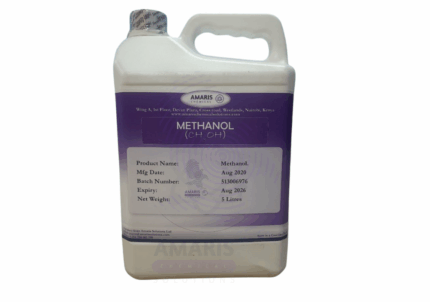Magnesium Carbonate Heavy Extra Pure
$ 23.47 Original price was: $ 23.47.$ 23.34Current price is: $ 23.34.
Magnesium Carbonate Heavy Extra Pure is a denser, high-purity grade of magnesium carbonate known for its exceptional stability, low solubility in water, and high absorbent capacity. It is widely used in pharmaceutical formulations as an antacid and magnesium supplement, and in food processing as an anti-caking agent and food additive. Its heavier bulk density makes it ideal for industrial uses such as in rubber and plastic manufacturing, where it serves as a reinforcing filler. In cosmetics, it contributes to moisture control in powders and skin care products. It is also valued in laboratories for analytical applications where precision and consistency are essential.
Magnesium Carbonate Heavy Extra Pure
Primary Uses
- Acid-Base Reaction Demonstrations:
- Commonly used to demonstrate carbonate reactions with acids, generating CO₂ and showcasing chemical neutralization.
- Reagent in Preparative Chemistry:
- Acts as a base or starting material for the synthesis of other magnesium salts or compounds.
- Drying and Absorbent Applications:
- Serves as a moisture-absorbing agent in desiccators or during sample preparation.
Secondary Uses
- Filler in Analytical Formulations:
- Used as an inert filler or bulking agent in laboratory blends or tablets.
- pH Control in Buffered Systems:
- Helps in moderating acidic environments during buffer preparation or titration studies.
- Educational and Demonstration Use:
- Suitable for teaching material in practical lab classes to illustrate principles of solubility, decomposition, and mineral analysis.
| PACK SIZE |
500 grams Plastic Tin |
|---|
1. Basic Identification Attributes
- Chemical Name: Magnesium Carbonate (Heavy)
- Synonyms: Heavy Magnesite, Basic Magnesium Carbonate (dense), Magnesium Carbonate Hydrate
- CAS Number: 546-93-0
- Molecular Formula: MgCO₃ or [MgCO₃·Mg(OH)₂·xH₂O] (for basic forms)
- Molecular Weight: Approx. 84.31 g/mol (varies slightly with hydration)
- Appearance: White, dense powder or coarse granules
- Odor: Odorless
- Solubility: Practically insoluble in water; soluble in dilute acids with effervescence
- Grade: Extra Pure (high purity, suitable for laboratory use)
2. Safety & Hazard Attributes
- GHS Classification:
- Not classified as hazardous under GHS
- Hazard Statements:
- No significant hazard under normal laboratory use
- Precautionary Statements:
- P261: Avoid breathing dust
- P280: Wear protective gloves and safety goggles
- P305+P351+P338: IF IN EYES, rinse cautiously with water for several minutes
- Personal Protective Equipment (PPE):
- Safety goggles
- Protective gloves
- Lab coat
- Dust mask (if airborne dust is generated)
- First Aid Measures:
- Inhalation: Remove to fresh air
- Skin Contact: Rinse with soap and water
- Eye Contact: Rinse cautiously with water for several minutes
- Ingestion: Rinse mouth; seek medical advice if large amounts ingested
- Fire Hazards:
- Non-combustible
- In case of fire, use extinguishing media appropriate for surrounding material
3. Storage & Handling Attributes
- Storage Conditions:
- Store in tightly closed containers
- Keep in a cool, dry, and well-ventilated area
- Protect from moisture and incompatible substances (e.g., strong acids)
- Handling Tips:
- Avoid inhalation of dust
- Use in well-ventilated spaces
- Practice good laboratory hygiene
4. Laboratory Applications
- Primary Uses:
- Analytical reagent for chemical and acid-base analysis
- Laboratory antacid or buffer in experimental reactions
- Standard for gravimetric and thermal analysis
- Secondary Uses:
- Thermal decomposition studies (to yield MgO)
- Educational experiments involving carbonates and acid reactions
- Demonstrations of gas evolution with acids
SAFETY PRECAUTIONS
Personal Protective Equipment (PPE):
- Wear a lab coat, nitrile gloves, and protective goggles.
- Use a dust mask or work in a fume hood to avoid inhalation of airborne particles.
Handling:
- Avoid generating dust.
- Do not breathe dust; minimize direct contact with skin and eyes.
- Handle in a well-ventilated area.
- Wash hands and exposed skin thoroughly after handling.
Storage:
- Store in a cool, dry, and well-ventilated place.
- Keep the container tightly closed and away from moisture.
- Avoid contact with acids, which can lead to the release of carbon dioxide gas.
FIRST AID MEASURES
Inhalation:
- Move the affected person to fresh air.
- Seek medical attention if coughing, shortness of breath, or irritation persists.
Skin Contact:
- Wash with plenty of water and soap.
- Remove contaminated clothing.
- Consult a doctor if irritation develops.
Eye Contact:
- Rinse immediately with clean water for several minutes.
- Remove contact lenses if present and easy to do.
- Continue rinsing and seek medical help if irritation continues.
Ingestion:
- Rinse mouth with water.
- Do not induce vomiting.
- Seek medical attention if discomfort occurs.
FIRE FIGHTING MEASURES
Flammability:
- Non-flammable.
- Fine dust may create a combustible dust hazard in air.
Extinguishing Media:
- Use dry chemicals, foam, carbon dioxide, or water spray.
- Avoid high-pressure water streams.
Hazardous Combustion Products:
- May produce magnesium oxide fumes when heated to decomposition.
Firefighter Protection:
- Use self-contained breathing apparatus (SCBA) and full protective gear.


 Preservatives(food)
Preservatives(food) Flavor Enhancers
Flavor Enhancers Acidulants
Acidulants Sweeteners
Sweeteners Antioxidants
Antioxidants Colorants(food)
Colorants(food) Nutraceutical Ingredients (food)
Nutraceutical Ingredients (food) Nutrient Supplements
Nutrient Supplements Emulsifiers
Emulsifiers
 Collectors
Collectors Dust Suppressants
Dust Suppressants Explosives and Blasting Agents
Explosives and Blasting Agents Flocculants and Coagulants
Flocculants and Coagulants Frothers
Frothers Leaching Agents
Leaching Agents pH Modifiers
pH Modifiers Precious Metal Extraction Agents
Precious Metal Extraction Agents
 Antioxidants(plastic)
Antioxidants(plastic) Colorants (Pigments, Dyes)
Colorants (Pigments, Dyes) Fillers and Reinforcements
Fillers and Reinforcements Flame Retardants
Flame Retardants Monomers
Monomers Plasticizers
Plasticizers Polymerization Initiators
Polymerization Initiators Stabilizers (UV, Heat)
Stabilizers (UV, Heat)
 Antifoaming Agents
Antifoaming Agents Chelating Agents
Chelating Agents Coagulants and Flocculants
Coagulants and Flocculants Corrosion Inhibitors
Corrosion Inhibitors Disinfectants and Biocides
Disinfectants and Biocides Oxidizing Agents
Oxidizing Agents pH Adjusters
pH Adjusters Scale Inhibitors( water)
Scale Inhibitors( water)
 Antioxidants(cosmetic)
Antioxidants(cosmetic) Emollients
Emollients Fragrances and Essential Oils
Fragrances and Essential Oils Humectants
Humectants Preservatives
Preservatives Surfactants(cosmetic)
Surfactants(cosmetic) Thickeners
Thickeners UV Filters
UV Filters
 Fertilizers
Fertilizers Soil Conditioners
Soil Conditioners Plant Growth Regulators
Plant Growth Regulators Animal Feed Additives
Animal Feed Additives Biostimulants
Biostimulants Pesticides (Herbicides, Insecticides, Fungicides)
Pesticides (Herbicides, Insecticides, Fungicides)
 Active Pharmaceutical Ingredients (APIs)
Active Pharmaceutical Ingredients (APIs) Excipients
Excipients Solvents(pharmaceutical)
Solvents(pharmaceutical) Antibiotics
Antibiotics Antiseptics and Disinfectants
Antiseptics and Disinfectants Vaccine Adjuvants
Vaccine Adjuvants Nutraceutical Ingredients (pharmaceutical)
Nutraceutical Ingredients (pharmaceutical) Analgesics & Antipyretics
Analgesics & Antipyretics
 Analytical Reagents
Analytical Reagents Solvents(lab)
Solvents(lab) Chromatography Chemicals
Chromatography Chemicals Spectroscopy Reagents
Spectroscopy Reagents microbiology-and-cell-culture-reagents
microbiology-and-cell-culture-reagents Molecular Biology Reagents
Molecular Biology Reagents Biochemical Reagents
Biochemical Reagents Inorganic and Organic Standards
Inorganic and Organic Standards Laboratory Safety Chemicals
Laboratory Safety Chemicals Specialty Laboratory Chemicals(Special Laboratory Equipment)
Specialty Laboratory Chemicals(Special Laboratory Equipment)
 Demulsifiers
Demulsifiers Hydraulic Fracturing Fluids
Hydraulic Fracturing Fluids Scale Inhibitors(oil)
Scale Inhibitors(oil) Surfactants(oil)
Surfactants(oil) Drilling Fluids
Drilling Fluids
 Dyes and Pigments
Dyes and Pigments Bleaching Agents
Bleaching Agents Softening Agents
Softening Agents Finishing Agents
Finishing Agents Antistatic Agents
Antistatic Agents
 Admixtures
Admixtures Waterproofing Agents
Waterproofing Agents Sealants and Adhesives
Sealants and Adhesives Curing Compounds
Curing Compounds Concrete Repair Chemicals
Concrete Repair Chemicals Anti-Corrosion Coatings
Anti-Corrosion Coatings
 Surfactants(cleaning)
Surfactants(cleaning) Builders
Builders Enzymes
Enzymes Solvents (Cleaning)
Solvents (Cleaning) Fragrances
Fragrances
 Electronic Chemicals
Electronic Chemicals Catalysts
Catalysts Lubricants
Lubricants Photographic Chemicals
Photographic Chemicals Refrigerants
Refrigerants Automotive chemicals
Automotive chemicals Pyrotechnic Chemicals
Pyrotechnic Chemicals
 Biodegradable Surfactants
Biodegradable Surfactants Bio-based Solvents
Bio-based Solvents Renewable Polymers
Renewable Polymers Carbon Capture Chemicals
Carbon Capture Chemicals Wastewater Treatment Chemicals
Wastewater Treatment Chemicals
 Pigments
Pigments Solvents(paint)
Solvents(paint) Specialty Coatings
Specialty Coatings Binders/Resins
Binders/Resins Additives
Additives Driers
Driers Anti-Corrosion Agents
Anti-Corrosion Agents Functional Coatings
Functional Coatings Application-Specific Coatings
Application-Specific Coatings
 Fresh Herbs
Fresh Herbs Ground Spices
Ground Spices Whole Spices
Whole Spices Spice Blends
Spice Blends Dried Herbs
Dried Herbs
 Leavening Agents
Leavening Agents Dough Conditioners
Dough Conditioners Flour Treatments
Flour Treatments Fat Replacers
Fat Replacers Decoratives
Decoratives Preservatives(baking)
Preservatives(baking)
 Plasticizers & Softeners
Plasticizers & Softeners Reinforcing Agents
Reinforcing Agents Adhesion Promoters
Adhesion Promoters Vulcanizing Agents
Vulcanizing Agents Antidegradants
Antidegradants Blowing Agents
Blowing Agents Fillers & Extenders
Fillers & Extenders Accelerators & Retarders
Accelerators & Retarders